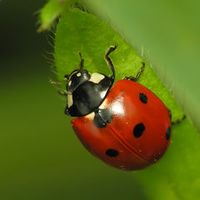Difference between revisions of "Ladybug"
(French name) |
TrainerX493 (talk | contribs) m (Removing unneeded category: Category:Insect) |
||
| Line 75: | Line 75: | ||
{{bugs}} | {{bugs}} | ||
| − | |||
Revision as of 12:48, September 13, 2013
- "I caught a ladybug! S-so cute! S-so small!" —City Folk
| ||||||
| 200px | ||||||
| Real-world info | ||||||
|---|---|---|---|---|---|---|
| Name: Coccinella septempunctata Family: Coccinellidae- Ladybugs | ||||||
| Main appearances | ||||||
|
| ||||||
| Other appearances | ||||||
Names in other languages
Unknown
Unknown Unknown Unknown
Unknown
Unknown Unknown Unknown
Unknown Unknown Unknown Unknown | ||||||
The ladybug (テントウムシ, Tentōmushi), known as the spotted ladybug in Animal Crossing, is a small, black and red insect that appears throughout spring and summer. They are common and worth 200 bells. They can also been seen in October. Ladybugs crawl on any sort of flower, appearing as a red spot on them (which makes it hard to find them on red flowers). They will fly away if you approach them too fast or walk onto the flower the were crawling on. Their buzzing when they fly is quiet, making it hard to notice you scared it away.
Donating to the Museum
As with all other fish and insects in the Animal Crossing series series, the ladybug can be donated to the museum by talking to Blathers the curator, who will also give information upon donation.
In Animal Crossing
Blathers, the curator of the museum, says the following when it is handed to him for donation;
"Ladybugs are one insect I thought might appeal to me. Then I made the grievous error of touching one. This vile fluid appeared from someplace and.. Oh, it was everywhere! Blech! Utterly appalling!"
The spotted ladybug can be found nestled amongst the flowers in the center of the insect room after donation.
In Wild World
When donated, this is what Blathers says;
"I've heard it said that ladybugs are "so cute!" Sadly, I must disagree. I touched one once, and this vile yellow fluid... Blech! I shan't discuss it... Hoo.. If that's "cute," then I weep for the world!"
After donation the ladybug appears in the museums first insect room, on the left side, on the flowers between the palm trees.
In City Folk
The following information is what Blathers says to the player upon donation of the ladybug;
"Mad as it sounds, I find a lone ladybug quite fetching... But they tend to cluster in cold weather. If you were to flip over a rock in winter, you might see the underside crawling with them... Such vileness! Bleeeech! The very thought gives me the quivers!"
After donation, the ladybug can be found sitting on a flower on the lower terrace of the insect room.
Encyclopedia Information
When the player has caught the ladybug, they can find information about the insect in the bug menu. Below is the information regarding the ladybug:
Wild World
''They survive the cold winter by forming clusters, which look like small ornaments."
|
City Folk
Further Information
There are roughly 5,000 species of ladybug, Coccinellidae, worldwide. Unknown to many, ladybugs are a type of beetle. The ladybug represented in the Animal Crossing series series is Coccinella septempunctata, the Seven-spot ladybug. It lives almost anywhere where there are aphids, its main prey, to eat. Ladybugs are considered by many to be beneficial to plants due to their eating habits- aphids themselves eat plants, so by introducing ladybugs, plants can be protected. The seven-spot itself was introduced to North America in this manner.
The yellow fluid that Blathers refers to is called reflex blood and has an unpleasant odor which keeps predators at bay if the warning colors do not suffice.
Ladybugs can lay several dozen eggs, which hatch after a period of three to four days. A number of infertile eggs are also released by ladybugs in order to provide food for their young - when food is scarce, the number of infertile eggs is much greater than the number of fertile ones.
Names in other languages
| Bugs | ||||||||||||||||||||||||||
|---|---|---|---|---|---|---|---|---|---|---|---|---|---|---|---|---|---|---|---|---|---|---|---|---|---|---|
| ||||||||||||||||||||||||||
